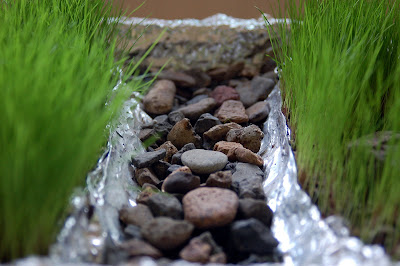 (Nile River model from The Story of the World I Activity Guide)
(Nile River model from The Story of the World I Activity Guide)
History and Literature: I know I’ve sung the praises of The Story of the World before, but you’ll hear it again today (and again in the future, I’m sure). The Story of the World is a four-volume chronological history of the world in a narrative style written for children. The author, Susan Wise Bauer (yes, of The Well-Trained Mind fame), has brilliantly managed to make world history accessible to elementary-aged students without sacrificing substance and style.
Having never studied ancient history in school, I was enthusiastic about this past year’s studies for my own sake. Levi and I both learned a great deal, more than I could have imagined packing into a first grade study of history. The Story of the World is engaging for a variety of ages, including adults with a minimal background in history studies.
The book is divided into forty-two chapters, many of the chapters include two or three shorter stories. Line drawings and simple maps are interspersed throughout the book.
The accompanying Activity Book is an absolute treasure and well worth the cost, even if one only uses half of the resources. For each chapter, the activity book provides review questions, sample narrations, black-line maps and map work instructions, coloring pages, additional reading suggestions for related history and literature (the book lists alone are worth the cost of the activity book), and instructions for multiple (and varied) crafts and activities (ranging from very simple to complex). I cannot imagine trying to accomplish everything in the book, but it is wonderful to have so many things to choose from to add to our history studies.
I enjoy having our literature selections tied in with our history studies. Both are enhanced as we relate them to one another. (We do read other children’s fiction, which I mentioned in the Language Arts post.)
The Story of the World: Volume 1 does contain some Biblical history (stories of Abraham, Joseph, Moses, and Jesus), but is not specifically a ‘Christian’ resource. The book does not address creation (it begins with nomadic life in 6000 BC), leaving it up to the parents to teach their own family beliefs. For those wishing to incorporate more Biblical foundations in their history studies, I very highly recommend The Children’s Illustrated Bible.

This gorgeous, detailed Children’s Bible contains an abundance of historical information and maps; drawings and photographs of artwork, geographical locations, artifacts, foods, people, animals; and so much more!! The stories are illustrated with tasteful pastel drawings. It is the perfect Biblical supplement to The Story of the World: Volume 1 for elementary students.
For those wondering how to pull together a history and literature curriculum, rest assured that The Story of the World (and Activity Book) does the hard part for you! Planning and scheduling might look something like this:
Monthly Planning: Look over suggestions for the next few chapters in Activity Book. Make a list of additional reading titles to check out at library or purchase. Add any activity supplies to shopping list.
Weekly Planning: Make sure you have books for additional reading and supplies for any crafts or activities. Make copies of maps or coloring pages.
Monday: Read next chapter in SOTW. (Let child work on coloring page while parent reads.) Review questions or narration. Map work. (45 minutes)
Tuesday: Read an additional history or literature selection* (either together or independently). (30 minutes)
Wednesday: Activity or craft. (30-45 minutes)
Thursday: Additional reading*. (30 minutes)
(* If we are reading a longer literature selection, I often read it in place of our fiction read-aloud rather than just reading during scheduled history time.)
You could plan less or more time depending on interests and abilities. You could also plan to do two longer sessions of an hour or more, rather than break it up in smaller chunks of time. (The revised edition of The Well-Trained Mind also has specific planning and scheduling ideas.)
We have finished The Story of the World: Ancient Times, and have moved on to The Story of the World: Medieval Times. I would have to say that History and Literature are our favorite subjects!
(All current history updates with be posted with the History label.)